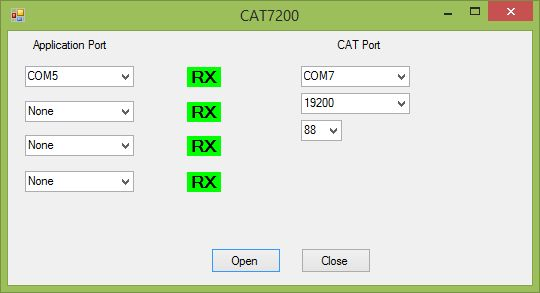
CAT7200 allows sound card based digital modem programs which support PTT via the RTS pin on a COM port but do not support ICOM CI-V PTT or CM108/CM119 based soundcato be used with ICOM rsdios with a built in soundcard or a CM108 interface. See below for more information on CM108 interfaces.converts changes in RTS on a virtual COM port to key a radio using either ICOM CI-V PTT commands or the PTT interface on certain CM108-based sound card interfaces. It intended to allow
sound card based digital modem programs which do not support ICOM CI-V PTT or the CM108 to be used with ICOM rsdios with a built in soundcard or a CM108 interface. See below for more information on CM108 interfaces.
The program works with either The the "User Mode Virtual Serial Port Driver" from the BPQ32 Node package, a pair of cross-connected real COM ports or a Virtual COM port pair, such as those provided by the com0com driver.
The following instuctions refer to the IC7100, but apply to any ICOM radio with built in soundcard.
Download the required files from
http://www.cantab.net/users/john.wiseman/Downloads/CAT7200.zip
and unzip to a onvenient folder.
Create a virtual COM port.
Note that there are separate versions for 32bit and 64bit Windows, in the VCOM32 and VCOM64 subdirectories - make sure you install the right one.
For Installation on Windows XP, see intructions here.
To Install on a Windows 8 64 bit system you must
reboot with advanced options to disable driver signature enforcement.
With Windows 7 and above, you should be able to install the driver by right clicking on InstallBPQVCOM.exe
(or InstallBPQVCOM32.exe if 32 bit) and selecting "Run as Administrator". If that fails, the instructions for using the old
method of installation are below.
For Installation on Windows 7+, see intructions here.
Use Device manager to identify the COM port numbers allocated to your 7100 and the Virtual COM Port.
Run CAT7200. You should get a screen something like

The CM108 and similar USB audio chips which are used in many low cost USB sound interfaces have some user controllable GPIO pins. Although these aren't usually connected it is possible to modify some of these interfaces to make this available for use as a PTT function or to build an interface from scratch using these devices. There are commercially available units and a lot of information on the web on DIY modifications. The GPIO pins are access by the operating system as a HID (Human Interface) device. The device I used for testing is described here.
John Wiseman, G8BPQ
January 2014